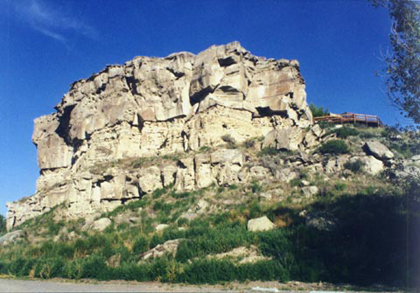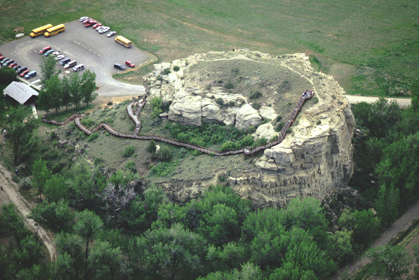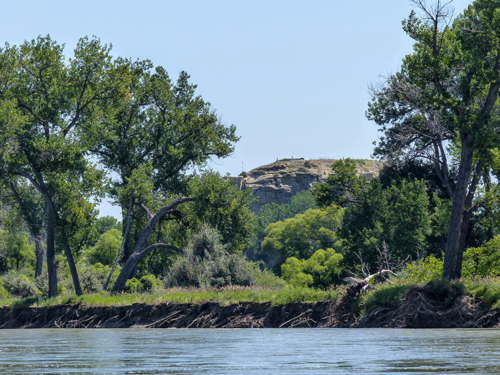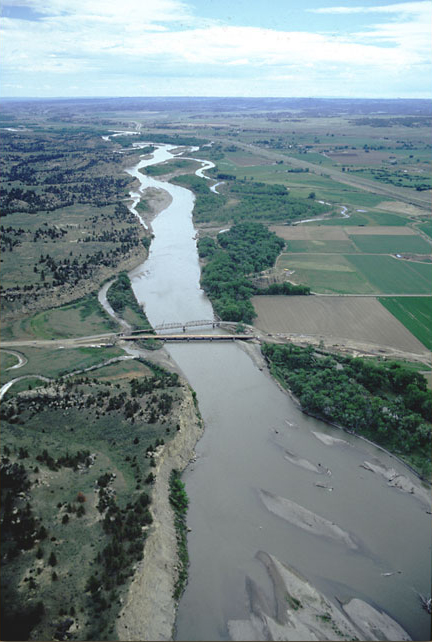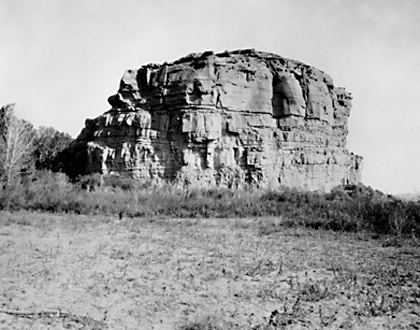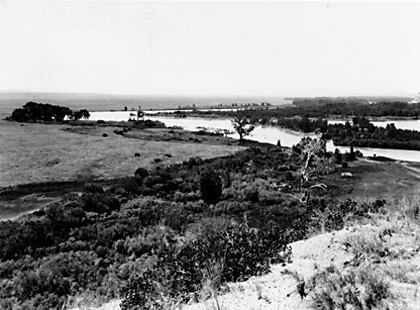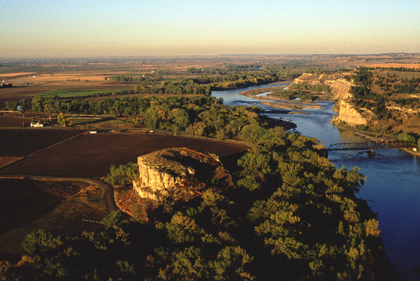The structure at right leads to Clark’s name. It is part of the wooden stairway and walkway to the top.
Bird’s Eye View
to see labels, point to the image.
© 2001 Jim Wark Airphoto.
Copies of Jim Wark’s aerial photos of the Lewis and Clark Trail
are available direct from AIRPHOTO North America.
At four in the afternoon of 25 July 1806, Clark and his contingent of nine men, plus York, Toussaint Charbonneau, Sacagawea, and little Jean Baptiste Charbonneau, arrived at “a remarkable rock Situated in an extensive bottom, on the Star[boar]d. [south] Side of the river & 250 paces from it.” That landmark can hardly be seen from the river today, for cottonwood trees, their seedlings no longer fodder for Indians’ horses, have filled in the broad riverbank between.
Clark’s Description
Clark measured the rock’s circumference at 400 paces, or about 1,200 feet, and estimated its height at 200 feet. The first dimension was fairly accurate, but the height was off by about 40 percent. Even today, having apparently suffered but little erosion, or even perhaps grown a few inches with humus from dead grass and shrubs, it reaches 121.88 feet or 127.42 feet, depending on the side from which one measures it.[1]Sixty years later another river traveler, who carried a copy of the 1814 edition journals, and watched for landmarks Clark had mentioned, estimated it to be more than 300 feet high! He didn’t … Continue reading Climbing to the summit of this “lightish Coloured gritty rock”—actually sandstone of the Cretaceous Hell Creek Formation—Clark found “a tolerable Soil of about 5 or 6 feet thick Covered with Short grass,” and took notes on the “most extensive view in every direction.”
The Indians have made 2 piles of Stone on the top of this Tower. The natives have ingraved on the face of this rock the figures of animals &c. near which I marked my name and the day of the month & year.
Clark named it “Pompy’s Tower,” in honor of the Charbonneaus’ young son, who sometime that summer had acquired the nickname Pomp. On his map, he named that large brook “River Baptieste” after Sacagawea’s 17-month-old son, adding parenthetically, “almost dry.”
A Most Extensive View
Where the Mountain Lion Sits
Burton Pretty On Top
Burton Pretty On Top, a member of the Crow Nation, relates his peoples’ legend about the landmark they call iish-biia ah-naac’he’, and describes its significance to them in the social, political, and economic history of the lower Yellowstone Valley.
William Clark described the view from atop “Pompy’s Tower”:
From the top of this Tower I could discover two low Mountains & the Rocky Mts. Covered with Snow S W. One of them appeared to be extencive and bore S. 15° E. about 40 miles. The other I take to be what the Indians Call the Little wolf Mtn. I can only see the Southern extremity of it which bears N 55° about 35 Miles. The plains to the South rise from the distance of about 6 miles the width of the bottom gradually to the mountains in that derection. A large Creek with an extencive Vally the direction of which is S. 25° E. meanders boutifully through this plain.
The “Rocky Mts Covered with Snow S W.” may refer to the Pryor Mountains an island range of arched crustal uplifts separated from the higher and more imposing Beartooth Mountains to the west by the valley of the Clark’s Fork of the Yellowstone. The north half of the Pryors is within the Crow Indian Reservation; the southern half includes the 32,000-acre Pryor Mountains Wild Horse Range, one of only two such preserves in the U.S.
The “Little Wolf Mtn.” the Mandans and Hidatsas evidently told him about may be Dunn Mountain, the “Southern extremity” of the isolated Bull Mountains.
On the Northerly Side of the river high romantic Clifts approach & jut over the water for Some distance both above and below.
Geologists believe Pompeys Pillar[2]The United States Board of Geographic Names omits the apostrophe from place names. See http://mapping.usgs.gov/www/gnis/bgn.html once was connected to those “romantic Clifts” until it was separated from them when the oxbow on which it stood was cut through at the base of its bend by a much larger Yellowstone River.
A large Brook which at this time has Some running muddy water falls in to the Rochejhone immediately opposite Pompys Tower. Back from the river for Some distance on that Side the hills are ruged & some pine. . . . The plains are open and extensive. After Satisfying my Self Sufficiently in this delightfull prospect of the extensive Country around, and the emence herds of Buffalow, Elk and wolves in which it abounded, I decended and proceeded on a fiew miles.
Hidden Landmark
As Lieutenant James Bradley, of the 7th U.S. Infantry, remarked in 1876, Pompeys Pillar, as a rock, is not impressive. It was “overtopped by the neighboring bluffs of which at one time it formed a part.” In those days it still marked a heavily used crossroads, river ford, camping ground and sacred site. There were few if any cottonwood trees around it, The surrounding floodplain was imprinted with the footprints of Indians and their horses, as well as bison and other wildlife. The ford, which centered about where those bridges are now, probably was well-worn and muddy. The place, its functions, and its meanings were known to man and beast, far and wide.
Today it is more of a destination in itself, a target, rather than a life-centered place. Today it is even less imposing, surrounded on three sides by a dense forest of cottonwood trees. From the interstate highway at upper right, and at superhighway speed, one can scarcely make it out, “overtopped” as it is by 80-year-old cottonwoods, and the higher cliffs on the opposite side of the river. It’s equally problematic from the air. Even knowing its approximate location in terms of navigational coordinates—latitude and longitude—of the rock, photographer Jim Wark made several passes over it without making visual contact, and had to make another trip from Pueblo, Colorado, just to get this shot.
The highway (Bundy Road) over the steel truss bridge connects this part of the Yellowstone Valley with the Musselshell Valley, beyond the Bull Mountains to the north (left). The old bridge was completed in 1915, the new one in the late 1990s. Charles Bundy settled on the north side of the Yellowstone here in the 1880s.
Changes Over Time
Compare the two early views above with the modern aerial photo taken in 1998. Notice the density of the cottonwood stand all along the south bank of the Yellowstone. After centuries of grazing and trampling on the tender cottonwood seedlings around this well-used ford by deer, elk, and bison, plus the traffic of Indians and their horses for about 150 years, several generations of cottonwoods have reclaimed the land.
Pompeys Pillar is a High Potential Historic Site along the Lewis and Clark National Historic Trail managed by the U.S. National Park Service. The site and interpretive center is managed by the U.S. Bureau of Land Management.—ed.
Notes
| ↑1 | Sixty years later another river traveler, who carried a copy of the 1814 edition journals, and watched for landmarks Clark had mentioned, estimated it to be more than 300 feet high! He didn’t stop to climb it. See J. Allen Hosmer, A Trip to the States by the Way of the Yellowstone and Missouri, with a Table of Distances (Virginia City, Montana Territory: Beaver Head News Print, 1867), 19. |
|---|---|
| ↑2 | The United States Board of Geographic Names omits the apostrophe from place names. See http://mapping.usgs.gov/www/gnis/bgn.html |
Experience the Lewis and Clark Trail
The Lewis and Clark Trail Experience—our sister site at lewisandclark.travel—connects the world to people and places on the Lewis and Clark Trail.
Discover More
- The Lewis and Clark Expedition: Day by Day by Gary E. Moulton (University of Nebraska Press, 2018). The story in prose, 14 May 1804–23 September 1806.
- The Lewis and Clark Journals: An American Epic of Discovery (abridged) by Gary E. Moulton (University of Nebraska Press, 2003). Selected journal excerpts, 14 May 1804–23 September 1806.
- The Lewis and Clark Journals. by Gary E. Moulton (University of Nebraska Press, 1983–2001). The complete story in 13 volumes.
